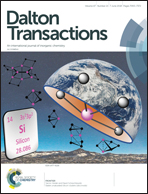Chiroptical methods in a wide wavelength range for obtaining Ln3+ complexes with circularly polarized luminescence of practical interest†
Abstract
We studied enantiopure chiral trivalent lanthanide (Ln3+ = La3+, Sm3+, Eu3+, Gd3+, Tm3+, and Yb3+) complexes with two fluorinated achiral tris(β-diketonate) ligands (HFA = hexafluoroacetylacetonate and TTA = 2-thenoyltrifluoroacetonate), incorporating a chiral bis(oxazolinyl)pyridine (PyBox) unit as a neutral ancillary ligand, by the combined use of optical and chiroptical methods, ranging from UV to IR both in absorption and circular dichroism (CD), and including circularly polarized luminescence (CPL). Ultimately, all the spectroscopic information is integrated into a total and a chiroptical super-spectrum, which allows one to characterize a multidimensional chemical space, spanned by the different Ln3+ ions, the acidity and steric demand of the diketone and the chirality of the PyBox ligand. In all cases, the Ln3+ ions endow the systems with peculiar chiroptical properties, either allied to f–f transitions or induced by the metal onto the ligand. In more detail, we found that Sm3+ complexes display interesting CPL features, which partly superimpose and partly integrate the more common Eu3+ properties. Especially, in the context of security tags, the pair Sm/Eu may be a winning choice for chiroptical barcoding.



 Please wait while we load your content...
Please wait while we load your content...